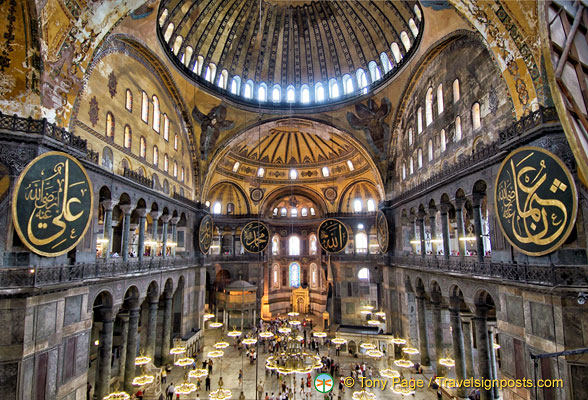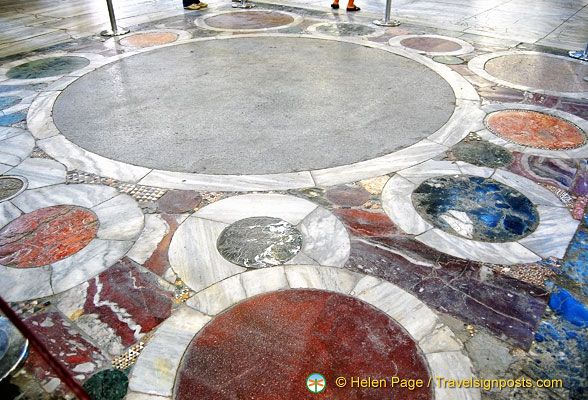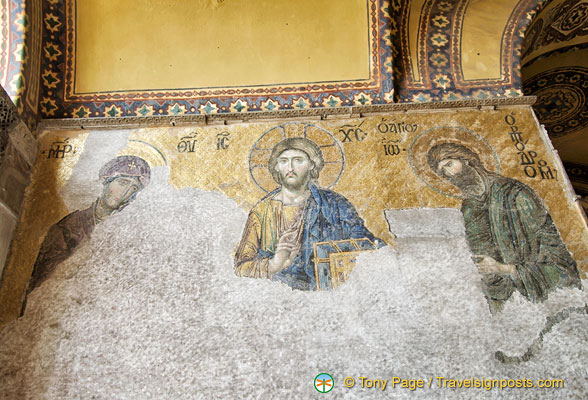Hagia Sophia or Aya Sofya is Istanbul’s Legacy of Christian and Muslim Cultures:
Hagia Sophia or Aya Sofya (The Church of the Holy Wisdom), was formerly a Byzantine church which was converted into a mosque when Sultan Mehmed II conquered Istanbul in 1453. When Turkey became a republic in 1934, Hagia Sofia was turned into the Ayasofya Müzesi (Ayasofya Museum), and is one of the top Istanbul attractions.
Hagia Sophia Brief History
There has been a church on the Hagia Sophia site since 360AD, but nothing exists of the first and second churches which were both destroyed during riots.
The church that we see today was built on the orders of Emperor Justinian I after the Nika Revolt in 532AD. More than 10,000 people worked on the construction of the church and material was brought in from all over the empire and the result was a basilica that was much larger and more majestic than its predecessors. For 1,000 years, up until the completion of the Seville Cathedral in the early 16th century, Hagia Sophia held the distinction of being the largest cathedral in the Christian world.
When Constantinople was captured during the Fourth Crusade in 1204, Hagia Sophia was ransacked and desecrated by the crusaders. The Doge of Venice (Enrico Dandolo) who commanded the invasion of the city is buried inside the basilica. Hagia Sophia was a Roman Catholic cathedral until 1261 when the Byzantines recaptured the city.
When Sultan Mehmed II conquered Istanbul in 1453, the church was desecrated and looted by the Ottoman Turks. Hagia Sophia was then converted into the Aya Sofya Mosque, the first imperial mosque of Istanbul. The minarets, fountains, mihrab and minbar were all added during this period. During the Turkish period, significant works were carried out, including the restorations by the Swiss-Italian Fossati brothers during the reign of Sultan Abdulmecid.
Ayasofya Müzesi
In a secular Turkey, Hagia Sophia was converted into a museum, the Ayasofya Müzesi, under the order of Kemal Ataturk in February 1935. The Hagia Sophia museum is now a UNESCO World heritage site.
Things to See at Hagia Sophia
Hagia Sophia is the legacy of both Christian and Muslim cultures and visitors to this church-mosque can experience Hagia Sophia’s rich heritage. With its building history going back to the 6th century, there are so many things to see in Hagia Sophia, as you can see from our Hagia Sophia photo gallery. Below are just some of the highlight features:
- On the architectural front, the building is a blend of Byzantine and Ottoman architectural designs.
- On the ground floor, where the nave of the cathedral used to be, you can see significant Ottoman additions such as the mihrab, the minbar, the sultan’s loge and the muezzin where Koran reading takes place.
- Just next to the muezzin is an area with colourful marble circles. This is the Omphalion (centre of the world) where the Byzantine emperor’s throne is located.
- If you have limited time at Hagia Sophia, make sure to allow time to get to the upper gallery. I missed it on our first visit and that was a mistake. There is an easy walkable ramp that leads from the ground floor to the upper gallery. From here, you have great views towards the apse of Hagia Sophia. The upper gallery also has important Byzantine mosaic panels depicting various Christian scenes. The most notable mosaic is the Deësis Mosaic. As you enter the South Gallery through the Marble Door, it is the first mosaic panel on the right. Partly damaged, it depicts a triumphant and kingly Christ (known as Christ Pantocrator – the All Powerful), flanked by the Virgin Mary and John the Baptist.
- The great dome, which was once covered with golden mosaic, is decorated with inscriptions from the Koran.
- Also prominent are the eight striking wooden medallions with Islamic scripts on them. These bear the names of Allah and Muhammad (flanking the apse), the first four Caliphs Abu Bakr, Umar, Uthman and Ali (at the four corners of the dome), and Hasan and Husayn (in the nave), the two grandsons of Mohammed.
Hagia Sophia is in the central tourist district of Sultanahmet and is a must-see on any Istanbul visit.
Address:
Ayasofya Meydani, Sultanahmet
Istanbul




 Take Better Digital Photos eBook
Take Better Digital Photos eBook Guerrilla Travel Photography eBook
Guerrilla Travel Photography eBook
Great article, and love the photos. Interestingly, although the Doge of Venice was originally buried in the Aya Sofya (Hagia Sophia), it is widely held here in Turkey, that following the Ottoman conquest of the city, his body was removed and thrown to the street dogs. There is an interesting article by Barbara Nadel, the author of crime novels set in Istanbul, that refers to this. http://www.shotsmag.co.uk/feature_view.aspx?FEATURE_ID=73
Hi Elizabeth,
Thanks once again for your nice comments, for following our posts and for this additional insight into the Doge of Venice. I thought that karma had caught up with the Doge, and for his role in the destruction and desecration of Ayasofya he ended up being buried there, so far from home. But according to your comment, it seems that an even worse fate followed.
Thanks for the link to Barbara Nadel’s interesting article. I hope the next time we visit Istanbul that I’m not haunted by spooky thoughts! Tony mentioned that you’re based in Istanbul – I had no idea! I hope you’ll keep sharing your local knowledge as we enjoy reading them.
Kind regards,
Helen
Is there a DVD available of Hagia Sophia in Istanbul? How can I order it?